Key Terms
barometer
buoyancy (Archimedes' principle)
check valve
hydraulics
pneumatics
pump
siphon
tire gauge
vacuum actuator
The term pressure is closely related to force. It is typically associated with the force a gas or a liquid exerts per unit area on the walls of its container. Typically the units are pounds per square inch (psi), millibars, or atmospheres, but there are many other units for pressure. Click link 2.4.a to see a conversion chart.
Pressure is force per area
Although you might not feel it, the pressure due to our atmosphere is actually quite high. At sea level, the pressure of the atmosphere is:
1 atmosphere = 14.7 psi = 1013 millibars
A check valve
A check valve is like a one way street for liquids or gases which operates on pressure differences. Liquids and gases always move from high pressure to lower pressure. A check valve is designed so that an obstacle blocks the motion of the fluid from moving in one direction. You can create a check valve by simply placing a rubber stopper over a drain opening. Water cannot drain out ... but there would be no resistance if water were to somehow flow up from the drain (Yuk!).
|
valve is open (right side has high pressure) |
valve is closed (left side has high pressure) |
A check valve is so simple yet so effective that it can be found in the human heart. Other examples are found in household plumbing ... a check valve is usually the first device you will find in the water supply to your house. It prevents high pressure water from moving back to your well or water source. A check valve is also found on the dump line of a sump pump. If you have a gas clothes dryer, you will find a similar device in the outside vent ... preventing colder air from moving inside your home.
When you check the air pressure in your tires, you may use a simple gauge where the tire pressure pushes out a calibrated rod. The higher the tire pressure, the farther the rod protrudes. The reading yields the gauge pressure in your tire. That is, how much it exceeds atmospheric pressure. A flat tire actually has an inside air pressure of about 14.7 pounds per square inch, but then again, so does the air on the outside of the tire so the gauge will read zero.
A simple tire gauge
Have you ever thought about how this type of pressure gauge works? For example, if the pressure in your tire is only 10 psi (gauge) it should push the rod out to that limit as long as it only has to work against atmospheric pressure. Ok, maybe it pushes against a spring! If so, why doesn't the rod retract back in the housing once you remove the gauge from the tire? If you have thought about these types of questions, you are a good candidate for becoming an engineer or scientist.
The fact is, the pressure in the tire does push against a spring (actually a piston backed by a spring). The piston will move to the point where the total force is the same on both sides. This also pushes out the calibration rod. When the gauge is removed from the tire, the piston retracts but the rod stays put.
A regular pressure gauge (or pressure cut-off switch) may use a simple flexible diaphragm to change a dial setting or turn off a pump.
A dial pressure gauge using a diaphragm (animation) |
A manual pressure shut-off switch (animation)
|
An aneroid barometer (link 2.4.b) works on the same principle as the dial pressure gauge demonstrated above. Any changes in air pressure work against a flexible sealed capsule, changing its shape in the process. Any physical displacements are magnified by levers and converted to a dial reading. Deep sea divers need a depth gauge and airplanes need altimeters (link 2.4.c) to indicate altitude. Both work on similar principles.
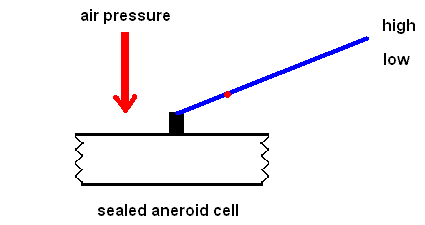
Aneroid barometer animation
Note: Understanding digital pressure gauges require a background in electricity, so we will cover that later.
If you look at your hot water heater, you will find a pressure relief valve somewhere. This is a safety device designed to prevent unsafe conditions. This is nothing more than simple "piston like" devices ... where the movement of the piston is controlled by the force of a spring (on one side) and the pressure of the water (on the other side). The piston normally provides a tight seal because the spring force is much greater than the force (pressure) of the water. This is reversed if the water pressure builds to unsafe levels ... releasing excess water and lowering the water pressure.
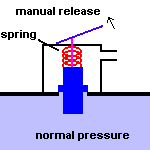
A typical hot water pressure relief valve (animation)
The pressure of liquids (hydraulics) or compressed gases (pneumatics) can be an incredibly useful tool. People learned long ago that you can tap into this energy source to make a task easier. The first example used by man has to be the water wheel.
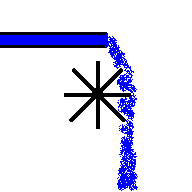
The Water Wheel (animation)
The water wheel was once used to provide power to grind flour. Later people used it in sawmills to run a saw and by the textile industry to run looms. When it was discovered that you could generate electricity by spinning a coil of wire in a magnetic field, hydroelectric power became a reality. Tesla was the first to use the power of running water to generate AC electricity at Niagara Falls. In all these cases, it is the gravitational potential energy of the water that is converted to the rotational energy of the wheel. Now huge turbines spin (using the pressure of steam) at coal fired and nuclear power plants to generate our electricity.

Spinning wheels are useful (animation)

Hydraulic or pneumatic motor (animation)
Cars use hydraulic brakes and trucks (and trains) use compressed air to force the brake shoe in contact with the brake drum. Trucks and trains use air brakes because it is easier to couple and uncouple air connections, making interchangeability easier.

Air Brakes (animation)
A pump is just the reverse of a water wheel.
A water wheel converts the energy in a fluid into rotational kinetic energy in the wheel ... the wheel receives the energy. That is, the water drives the wheel!
A pump converts the rotational kinetic energy of a wheel to energy in a fluid ... the wheel supplies the energy. That is, the wheel drives the water!
In the examples above, energy is delivered to the wheel by falling water. The pump uses energy from a spinning wheel to deliver energy to a fluid. This is how water is circulated through the cooling system of your car (a fan belt coming off the crankshaft provides the power to spin the water wheel).
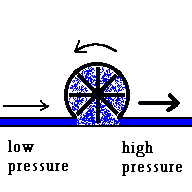
A simple water pump (animation)
A vacuum cleaner is nothing more than an air pump. The low pressure side of the pump makes contact with your floor. Since dust particles and dried up pizza pieces will tend to move from high pressure to lower pressure ... you get a cleaner floor.
Consider an open container of water with two holes on the side (so the water can run out). See below:
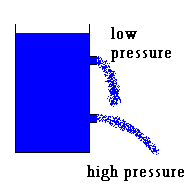
From the diagram, you will agree that the pressure at any level depends on the height of the water column. As the water runs out and the height of the water column drops, the pressure at both openings will decrease ... but the lower opening will always have more pressure than the one above it (regardless of the shape of the container).
Water by virtue of its height has energy! The higher it is, the more pressure it can deliver.
Now you can see why some communities build tall towers to store the city supply of water. By virtue of the water's height, it is able to provide high pressure water to meet demand. Of course, this energy source is not free. During the night (when electric rates are the cheapest), the city must invest in a small pump to lift more water to the reservoir for the next day..
If you live in a big city, water pressure (like Milwaukee ... click link 2.4.e) must be maintained by huge pumps. These pumps are always on to make sure you always have water pressure to your home.
If you own a home with its own well, you also have a "pressure tank"
which is able to store about 40 gallons of water. The function of this
tank is to provide a constant pressure in the water system (and to prevent the
well pump from burning out). The tank contains not just water but also a
layer of air. As the pump fills the tank with water, it also
compresses the air. Once a pressure of about 60 PSI is reached, the pump
shuts off ... but you still have lots of pressure as you start using water ...
even if you are taking a shower. It comes from the compressed air which is
a form of elastic potential energy. The reason this will not work with
water alone (no air) is because liquids do not compress easily. If your
pressure tank did not have any air in it, the pump would constantly switch on
and off several times even if water was slowly dripping from the faucet.
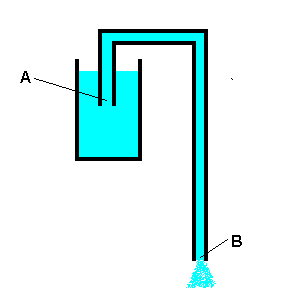
Most people think a siphon works because of differences in air pressure ... wrong! It works because of differences in water pressure. Consider the diagram above. The air pressure at points "A" and point "B" are essentially the same (only if the tube is very long will you need to take this fact into account). However, the water pressure will be much different! The water pressure at point A is less than the water pressure at point B (as long as point B is below point A). In other words, the water pressure at B is always greater than A. But there is a much greater (but equal) amount of air pressure (about 14.7 psi) pushing water up the tube at each end. What is the net pressure at each opening?
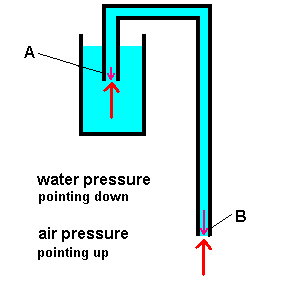
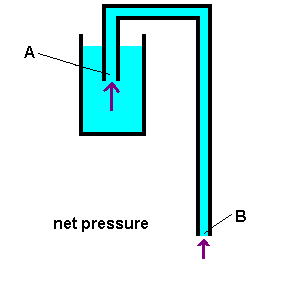
It should be clear that the net pressure at point A is higher than the net pressure at point B, so water will flow from point A to point B (as long as there is water completely filling the tube).
A common toilet (like the one in your house) also works because of pressure differences in the water. Most people think that the holding tank (behind the commode) is the central mechanism. This tank is simply a kick start to get you ready for the next flush. In fact, you can make a toilet flush by simply dumping about 2 gallons of water (quickly) into the bowl.
The waste system consists of a "U" shaped pipe which is partially blocked by a small amount of water so waste fumes do not enter the room. When you flush, the reservoir releases a rush of water that quickly fills the entire pipe system (which will not work if the water enters slowly) ... displacing the air in the gooseneck. This creates a siphon. As long as the "U" shaped pipe is flooded with water, waste fluids will continue to flow through the pipe. Once the bowl is completely drained, air rushes in ... breaking the siphon.

How a toilet works (animation)
Not too many people use pressure cookers since microwave ovens cook food so fast. However, I remember this item as a staple in the kitchen. Mom could prepare a delicious meal in a fraction of the time with this mysterious device, but I'm sure she had no idea how it worked.

A pressure cooker: Courtesy Wikimedia Commons
The key to understanding this device is to consider cooking some hard boiled eggs in a conventional pan. Once the water reaches the boiling point, the temperature remains the same so you need to keep the eggs in the water for about 10 minutes to fully cook them. At sea level, water boils at 212 degrees Fahrenheit. The reason the water doesn't rise above this temperature is because any heat added to the water goes to breaking molecular forces of attraction within the liquid ... freeing molecules, one by one, to a vapor. Try the same thing at a very high altitude and you will find that the eggs may require 15 minutes to prepare. Why? Because the lower atmospheric pressure changes the boiling point of water, lowering it several degrees. Since the eggs are boiling at a significantly lower temperature, they must cook longer. If you reverse the reasoning, cooking food in a higher pressure environment will mean that the water will boil at a much higher temperature. You can cook the same eggs in a few minutes.
Cars have devices which work off a vacuum system. This simply means that the air pressure in the hoses is less than atmospheric pressure. In most cases, the vacuum is initiated by the air intake system (intake manifold). Once a vacuum is established, you can initiate large pulling forces from slight pressure differences. These "pulling forces" can then be used to turn things on, or off, or make adjustments in some other devices. For example, a "vacuum actuator" may be used to adjust the throttle cable in the cruise control system in your car. Vacuum actuators can also control the temperature in a car by opening and closing vents.
To see how that works, consider a simple plunger resting on the floor. Normally, the pressure on both sides of the plunger will be equal. But imagine you slowly start drawing air from the inside of the plunger. This will set up a pressure difference between the outside atmospheric pressure and the inside of the plunger. The plunger responds by collapsing, drawing the handle of the plunger downward. This idea is the key to understanding how a vacuum actuator works. How much force can the handle exert? It turns out quite a bit! Working against a pressure difference of only 1 pound per square inch can really add up if the total surface area of the plunger is 10 square inches, producing a total force of 10 pounds (1 pound/in2 x 10 in2 = 10 pounds).

The force produced from a vacuum actuator can be huge (animation).
This was demonstrated in dramatic fashion in 1654 by Otto von Guericke when two teams of horses were unable to pull apart two hemispheres held together only by a vacuum. Click link 2.4.f or link 2.4.g
When you apply the brakes on your car, you are trying to move a piston in the master cylinder (a hydraulic system). Although you could provide the input force by yourself, the task would give you a pretty good workout in a short time. To help you out, a vacuum system provides some assistance in a device known as a vacuum booster.
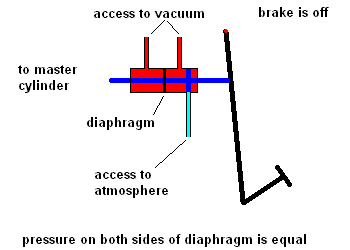
Vacuum booster (animation)
A flexible diaphragm is attached to the rod which goes to the master cylinder. Normally a vacuum is drawn on both sides of this diaphragm so there is no tendency to move in either direction. However, once the brake is applied, one side of the chamber is exposed to atmospheric pressure. Air fills this chamber and the pressure suddenly increases, causing the diaphragm to flex toward the low pressure side. Since the rod is attached to the diaphragm, it provides a "boost" to your foot action.
You should realize that the vacuum doesn't really "pull" things in. Gases can only exert "pushing" forces. The force is realized because there is a pressure difference ... and the outside pressure is simply greater than the inside pressure. So the next time you "suck" on a straw to drink a beverage, realize that you are not "pulling" the liquid up the straw ... it is the greater outside pressure pushing the liquids up the straw.
When you watch the weather, the reporter usually states the current atmospheric pressure in inches of mercury (for example 30 " Hg). That is, the pressure required to force mercury up a closed end tube. Again, the vacuum does not "suck" the mercury up the tube, the atmosphere pushes it up the tube until an equilibrium is reached (atmosphere equals pressure exerted by the weight of the mercury).
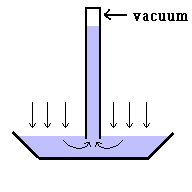
A mercury barometer (animation)
When the air pressure is rising, the column of mercury moves up the tube. When the pressure is dropping, the column moves down.
The easiest method of creating a vacuum is with a transfer pump (shown in the animation below). An impeller forces gas molecules out an exhaust valve. This creates a local vacuum behind the impeller which is filled in by some of the remaining gas molecules in the chamber. These molecules are then swept to the exhaust the next time the impeller passes by. The process continues until the desired vacuum is achieved. Only partial vacuums are practical with this device since it gets progressively harder to remove the very last molecules.
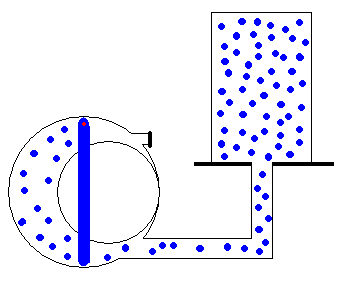
Vacuum Pump (animation)
To achieve nearly perfect vacuums, a capture pump is required. Basically you need to find a way to chemically or physically remove the gas molecules from the chamber. If the gas reacts chemically with a solid, a hard vacuum is achieved as individual molecules precipitate as a thick film on the chamber wall. Another approach is to expose the chamber wall to extremely low temperatures. The gas molecules condense on the chamber wall much like water vapor condenses on the outside of a glass holding a cold beverage.
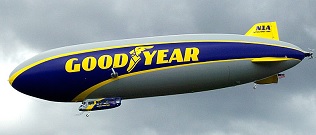
Courtesy Wikimedia Commons
How is the Goodyear© Blimp able to stay airborne? It weighs over 6 tons!!! It is filled with helium which is less dense than air so it acquires a buoyant force. You could ask why a submarine doesn't sink and you would get a similar type answer - buoyancy. What is buoyancy and how is it achieved? Consider the case where you were holding a 50 pound rock over water and the rock had a volume of 1 gallon. Now lower the rock in some water so it is barely submerged. Suddenly the tension in the rope is less (by about 8 pounds). Why is the tension lessened by 8 pounds? The buoyant force is equal to the weight of the displaced liquid (one gallon of water weighs about 8 pounds). This is known as Archimedes' principle. Does the tension change as you lower the rock deeper into the water? No! Water is not compressible so the density stays constant at any depth, meaning a gallon of water will always weigh 8 pounds.
Let's take a closer look at this. You can thank the fact that water pressure increases with depth for this lift we call buoyancy. Think of it this way .... consider the small red arrow at the bottom of the rock (in the image below) as the water pressure at that depth. It pushes the rock up, but there is no corresponding red arrow pushing down since the top of the rock is at the surface. As you lower the rock to greater depths, the forces on the rock increase but the key is there will always be more upward force than downward force. The difference is equal to the buoyancy and that will never change as long as the density of the water remains constant (at any depth).
The principle of buoyancy
Archimedes' principle explains why boats float and blimps fly. Just remember that the buoyant force is always equal to the weight of the displaced fluid.
Question: If you placed a 200 ton battleship in water, how much water will it displace? Answer: If the battleship floats (and you hope it does), it is 100% buoyant so it must displace 200 tons of water. The water weighs 200 tons = 200 tons x 2000 pounds/ton = 400,000 pounds. A gallon of water weighs about 8 pounds ... so 400,000 /8 = 50,000 gallons of water.
©2001, 2004, 2007, 2009, 2016 by Jim Mihal - All rights reserved
No portion may be distributed without the expressed written permission of the author